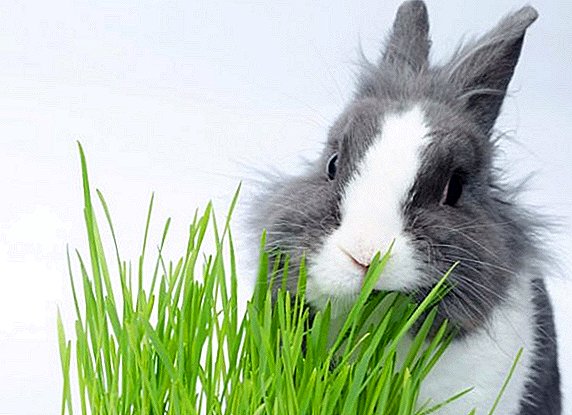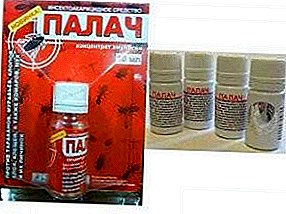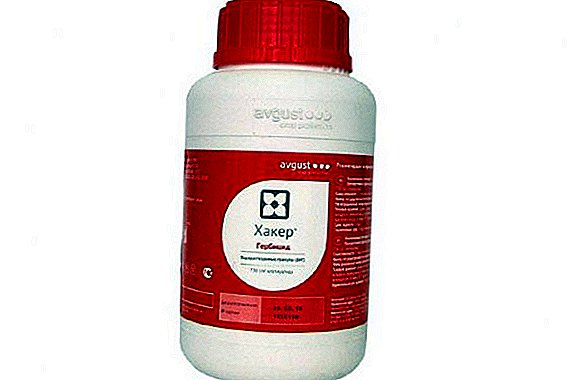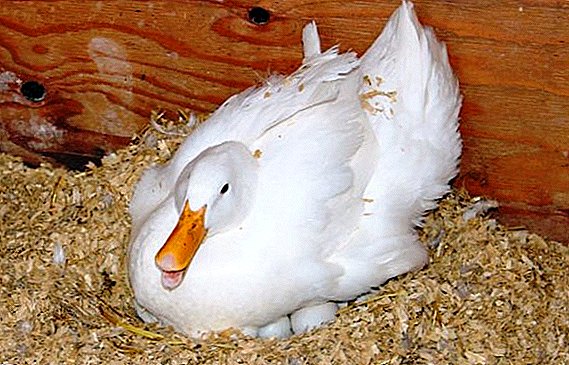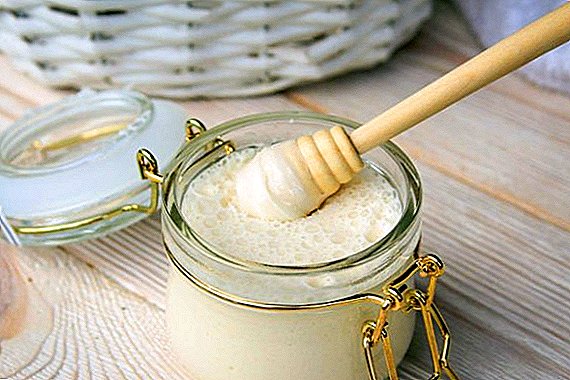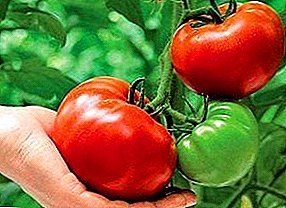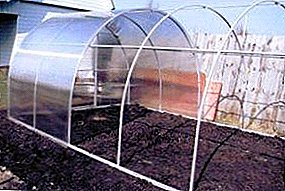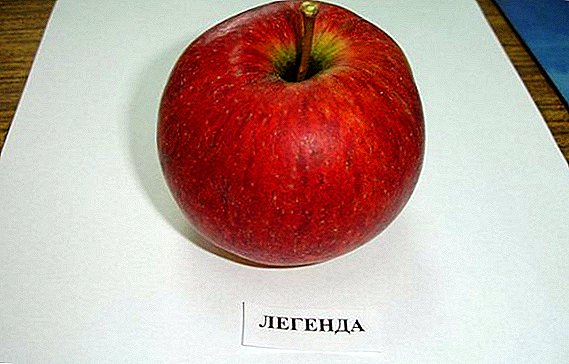 Recently, for various reasons, the once popular and famous apple varieties, such as Golden, Macintosh, Mantet, are increasingly rarely found on the shelves of markets and shops. But thanks to the efforts of breeders, new, previously unknown varieties began to appear. One of these is "Legend", which is an unusual small trees, covered with beautiful red fruits in autumn.
Recently, for various reasons, the once popular and famous apple varieties, such as Golden, Macintosh, Mantet, are increasingly rarely found on the shelves of markets and shops. But thanks to the efforts of breeders, new, previously unknown varieties began to appear. One of these is "Legend", which is an unusual small trees, covered with beautiful red fruits in autumn.
Selection
Apple tree "Legend" It originates from the Japanese Fuji variety, which has recently been recognized as the world leader among various apple varieties.  In this ranking, the second and third place is occupied by varieties that lag behind at times "Fuji" in yield.
In this ranking, the second and third place is occupied by varieties that lag behind at times "Fuji" in yield.
Check out the most popular varieties of apples: "Lingonberry", "Gala", "Florina", "Gift to gardeners", "Anis", "Golden Delicious", "Solntsedar", "Jonagold", "Arkadik", "Wonderful", " Jung, Starkrimson, Ola and Idared.
The main difference between "Legends" and "Fuji" is frost resistance. Our frosted champion our frosts are not suitable. The Legend is more like not its direct ancestor, Fuji, but rather its forefather — Royal Janet, the parent of Fuji.
From their ancestors "Legend" took the best qualities, adding to their resistance to our frost. The variety is early winter, the fruits are large, the correct beautiful shape. Apples on the branches look just wonderful: everything is like a selection in size, bright red.  The variety was bred in 1982, at the Moscow All-Russian Selection and Technological Institute of Horticulture and Nursery.
The variety was bred in 1982, at the Moscow All-Russian Selection and Technological Institute of Horticulture and Nursery.
Prof. V. Kichin, Doctor of Biological Sciences, headed the selection works. The variety was listed in the State Register in 2008.
Did you know? The ancient Irish and Scots had a custom to define the name of their betrothed on the apple peel, they threw it over their shoulders and looked at: which letter most resembled the fallen peel, the name of the beloved will begin with that.
Tree description
The tree is compact, columnar, with a very small number of branches. It tolerates not only winter frosts, but also quite cool summers with precipitation.  The tree reaches a height of three meters. The crown is small, compact, the leaves are shaped like an egg.
The tree reaches a height of three meters. The crown is small, compact, the leaves are shaped like an egg.
Read more about columnar apples and what you need in order to grow such apples in your garden.
Fruit Description
Fruit weight - 150-180 g and more. The shape of a truncated cone resembles a trapezoid in a section. The rind is thick and shiny. The color of the pulp is yellow with a greenish tinge, the peel is bright red.
Caramel notes have a sweet taste, tasters rate it at 4.5 on a five-point system. 
Characteristics of a variety
During breeding work, all the shortcomings of the Fuji variety and other modern apple varieties were taken into account. Most of them were avoided in the new variety.
Disease and Pest Resistance
To pests and diseases resistance is good. It fully complies with the requirements put forward to popular varieties.
Drought resistance and frost resistance
As already mentioned, the tree perfectly tolerates the winter frosts and heavy summer precipitation characteristic of our latitudes.
Important! In terms of its frost-resistant qualities, Legend is not inferior to the recognized leader in this category, the famous Antonovka.
Gestation period
Maturation occurs in late September-mid October.
Fruiting and Yield
If the tree was planted in the spring, the first harvest can be harvested in the coming autumn. The full yield of the tree gives, on average, in the sixth year.
With proper care from one tree you can collect up to 1 centner of apples, and with increased care, you can increase the yield by almost 100%.
It will be useful for you to read how to make an apple tree bear fruit.
Transportability and storage
Crop harvested in early October, beautifully stored until early next year. In the middle of winter, you can feast on apples quite salable, with excellent taste.
Normally transfers transportation when the necessary recommendations are followed. 
Growing conditions
Land for planting apple trees should be loose, with deep groundwater. The place should be protected from winds that can harm ungrained trees.
Time and landing scheme
You can plant a tree in the fall (late September-early October) or in the spring (second or third decade of April).
Carefully go to the purchase of seedlings. Acquire planting material should be from proven suppliers, with a reputation. Pay special attention to the root system, it must be flexible.
The foliage on the seedling should not be, it is removed in the fall, so that the seedling does not dry out.
The depth of the hole depends on each particular seedling. Should be guided by the root neck, located below the place where the tree was grafted. The neck should be 6-7 cm above the soil level.  Pits for planting should be prepared 25-30 days before the planned planting of trees. The pit should settle and crumble. Top fertile soil should be set aside for later use.
Pits for planting should be prepared 25-30 days before the planned planting of trees. The pit should settle and crumble. Top fertile soil should be set aside for later use.
The diameter of the pit should correspond to the size of the root system of each particular seedling.
Important! In the year of planting, it is recommended to pluck the color of the apple tree, thus directing all the forces of the tree not to flowering, but to rooting.
- Burn the peg on one side (0.5-0.7 m long), hammer it into the ground with the burned end.
- At the bottom, pour a mixture of deposited fertile soil, humus and peat, taken in equal parts. After 4 weeks the pit is ready for planting.
- Straighten the roots of the seedling and plant the tree north of the peg. Tie a seedling to a peg and fill the hole, periodically trampling down the ground.
- At the end of the procedure you should water and feed the tree. Top dressing is carried out by manure diluted in a bucket of water (1 shovel) and saltpeter (1 spoon). Pour 2 liters under each seedling.
Basics of seasonal care
Seasonal care for the Legend apple tree is not much different from similar work carried out with other varieties. Let's pay attention only to some moments. 
Soil care
Mulching does not allow the soil around the tree to dry out and prevents the growth of weeds. It is necessary to pay attention to the trunk circle. It should be regularly loosened and removed weeds.
We recommend that you know what types of weeds there are, how to remove weeds from the garden, which herbicides will help get rid of them, which tool to choose to remove weeds from the roots and which lawn grass will help to destroy the weeds.
Along the contour of the circle, within a radius of 1 m, you can pour a small earthen bank, 5-7 cm high. When watering, it will hold water inside the circle.
With a long absence of precipitation, the tree must be watered. Young trees are watered quite often, adults - less often and plenty of water.
Top dressing
For better survival, it is advisable to liquid feed three times with nitrate or urea. Weeds, competitors in the fight for nutrients, are removed from the tree circle, and the earth is carefully and shallowly loosened.  In early spring, young trees are fertilized with nitrogen, in summer and autumn - with potash-phosphorus fertilizers.
In early spring, young trees are fertilized with nitrogen, in summer and autumn - with potash-phosphorus fertilizers.
Adults - feed during the budding and flowering of mineral fertilizers, containing mainly potassium and phosphorus.
Important! Late introduction of nitrogen (in August) has a bad effect on frost resistance.
Cropping and crown formation
Formation of the crown should be carried out not only for beauty - the correct crown contributes to a good harvest. The procedure must be done annually, before the buds bloom.
The main points to pay attention to when forming the crown:
- thinning branches;
- removal of damaged and underdeveloped young branches;
- the mass of the cut branches should not exceed 25% of the total green mass of the tree.

Read more about spring and autumn pruning of apple trees, as well as how to properly prune old apple trees.
If there is a need for this, sanitation can be carried out - pruning of damaged branches after the entire harvest is gathered. In this case, the procedure is the stage of preparation for the winter, the cut points are processed by garden pitch.
Preparing for the winter
Within two weeks after harvest, it is necessary to prepare an apple tree for wintering. At this time, the root system is quickly restored. And in case some roots were damaged during digging, they will quickly be able to heal wounds.
To begin with, free up the tree trunk circle from the mulch, dig it and apply phosphate and potash fertilizers.
They help to strengthen the root system, in contrast to nitrogen, which is needed for the growth of green mass (respectively, its time will come in the spring).
If necessary, make an autumn pruning, as indicated above.
Did you know? An apple, probably the most "important" fruit in the world. "The apple of the knowledge of good and evil" in the Bible, the "apple of discord" in ancient Greek mythology, thanks to this same fruit, Newton discovered the law of universal aggression.
Wintering is better tolerated by trees, which receive the full range of fertilizers in March, and in August only potassium and phosphorus. Pre-winter watering is necessary, however, it is impossible to re-moisten the soil.
The last watering should be done during the final formation of the fruit.
Cover the lower part of the trunk with roofing felt, cardboard and mulch from rodents. A fir-tree can be put around the trunk and near-stem circle, it will contribute to the snow retention. But you can not cover the trunk with fallen leaves, it can be rodents.
You will be useful to learn how to deal with rodents at home and in the garden.
In addition, a fungus lives on the foliage, provoking the development of scab, so it must be removed. After dropping the foliage, treat the wood with iron sulfate or urea to prevent disease and protect against pests.
Fallen apples should also be removed or buried deeper. Remove caterpillars and mummified fruits from branches - pests can live in them.
Lime the stem with fungicide added, preliminarily ripping off the dead outer layer of the bark. Whitewashing the trunk will not only protect against frostbite, but also from the bright spring sun.  Young trees should be spud to a height of 0.3-0.4 m and mulch the perennial circle with peat (3-4 cm thick). This should be done in the event that frost occurred before the snow fell.
Young trees should be spud to a height of 0.3-0.4 m and mulch the perennial circle with peat (3-4 cm thick). This should be done in the event that frost occurred before the snow fell.
If there was no frost before the first snow, it is not worth spuding - the trunk may rot. In the spring you need to remove the hilling in time for the same reason.
Apple use
In addition to simple eating, apples are made from jam, compotes, homemade wine (cider). Fresh apples are an excellent filling for pies and pies.
We recommend that you learn the best recipes for harvesting apples for the winter, in particular with the peculiarities of cooking dried apples for the winter, and also learn how to make apple moonshine at home.
Home-made apple juice is a delicious and healthy drink.
Fruits are also dried for the subsequent cooking of dried fruit compote.
Pros and cons varieties
First, on the pros of the Legend variety:
- excellent frost resistance;
- resistance to disease characteristic of apple trees;
- columnar compact tree shape;
- excellent presentation;
- great taste;
- unpretentious care;
- Easily adapts to any climate.
 Of the significant disadvantages can be identified (with a stretch) only two:
Of the significant disadvantages can be identified (with a stretch) only two:- high price of seedlings;
- short life and fruiting of a tree (up to 15 years).
Did you know? In 1647, Peter Stavesant planted an apple tree in New York in Manhattan, which still bears fruit.
It can be stated unequivocally that if you decide to plant a Legend variety apple tree on the plot, do not give up your desire.
A beautiful and unusual tree with excellent frost resistance, unpretentious care and high yield - a few years ago, this combination seemed fantastic. Today, thanks to breeders, fiction is becoming a reality.


